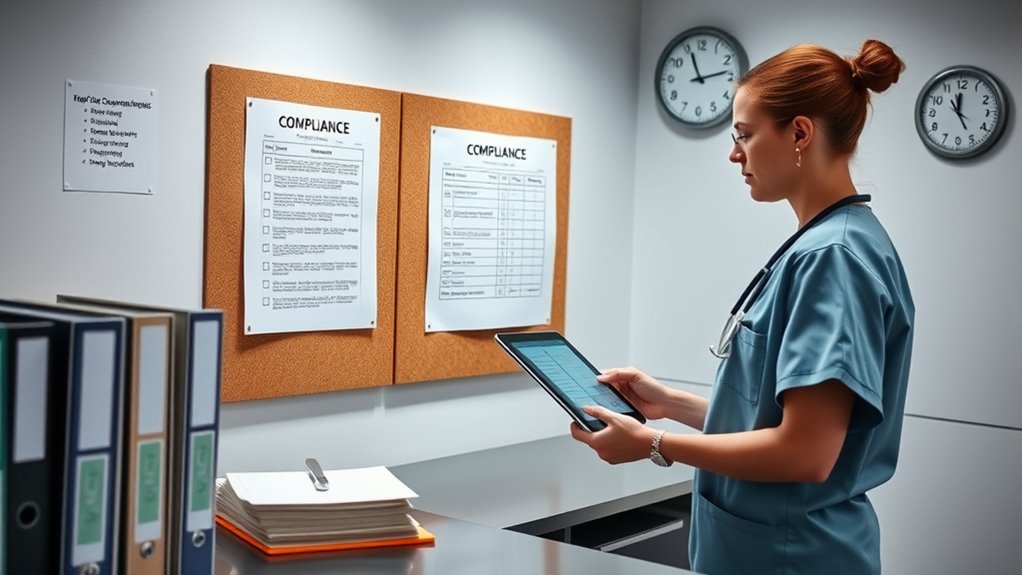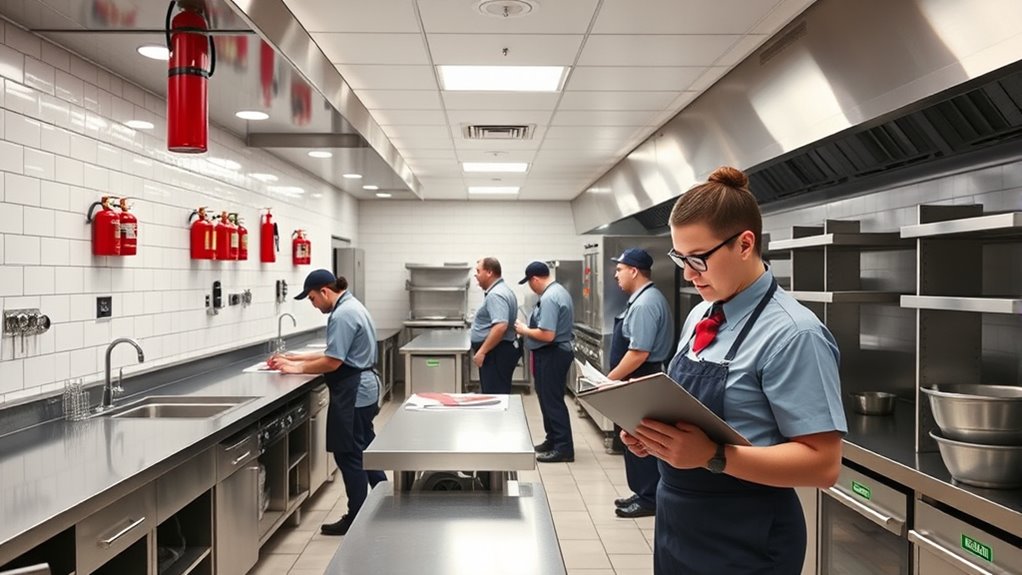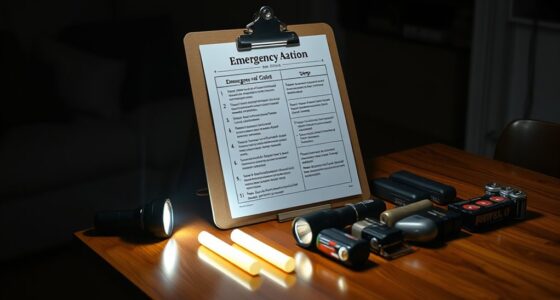To prepare for surprise health inspections, regularly review and update your policies, keeping documentation current and organized. Train your staff consistently on sanitation, safety, and best practices, using scenario simulations to boost confidence. Maintain daily cleanliness by disinfecting surfaces, organizing the facility for easy access, and monitoring hygiene protocols. Stay informed about changing regulations and develop a clear response plan. Keep maintaining high standards—if you follow these steps, you’ll be ready when it counts.
Key Takeaways
- Regularly review and update policies, procedures, and records to ensure compliance and readiness for inspections.
- Conduct frequent staff training and simulation scenarios to reinforce sanitation standards and inspection preparedness.
- Maintain a clean, organized facility with daily cleaning routines and strict personal hygiene protocols.
- Stay informed on current regulations and develop a comprehensive, accessible inspection response plan.
- Foster a culture of compliance through leadership, open communication, ongoing training, and staff recognition.
Regularly Review and Update Your Policies and Procedures

Regularly reviewing and updating your policies and procedures is essential to stay compliant with health inspection standards. You should schedule routine reviews—at least quarterly—to ensure your protocols reflect current regulations and best practices. During these updates, check for changes in local health codes, sanitation guidelines, and food safety practices. Make sure your procedures clearly outline staff responsibilities, cleaning schedules, and storage requirements. Keeping documentation accurate and up-to-date shows inspectors you’re proactive and diligent. Additionally, involve your team in the review process to gather insights and reinforce compliance culture. Regular updates also help you maintain preparedness for sudden inspections and demonstrate your commitment to maintaining a safe, clean environment. Staying ahead of potential issues reduces the risk of penalties and guarantees you’re always prepared for surprise inspections.
Conduct Routine Staff Training and Refresher Courses

You need to keep your staff sharp by conducting regular training and refresher courses. This helps reinforce their knowledge, guarantee they stay updated on protocols, and feel confident during inspections. Simulating inspection scenarios can also prepare them to respond effectively under pressure. Incorporating meal prep techniques into training can further enhance their ability to maintain consistent quality and safety in food handling.
Staff Knowledge Reinforcement
To guarantee staff remain confident and compliant during surprise health inspections, conducting routine training and refresher courses is essential. Regularly revisiting key procedures helps reinforce your team’s understanding of sanitation standards, safety protocols, and inspection expectations. These sessions should focus on practical application, addressing common pitfalls and updates in regulations. Encourage open discussions so staff can clarify doubts and share best practices. Consistent reinforcement ensures everyone stays sharp and knowledgeable, reducing the risk of overlooked violations. Well-trained staff can respond quickly and confidently to inspector queries, demonstrating your commitment to quality and compliance. Scheduling training sessions at regular intervals, and keeping records of attendance and topics covered, is vital. This proactive approach minimizes surprises and helps your team stay prepared at all times. Additionally, staying informed about Louisiana alimony laws and other legal requirements can help ensure your staff understands the broader legal context of compliance.
Updating Protocols Regularly
Updating protocols frequently keeps staff prepared for evolving health inspection standards. Regularly review and revise procedures to ensure they reflect current regulations. Conduct routine staff training and refresher courses to reinforce best practices. This approach helps your team stay sharp and confident during inspections. To illustrate, consider this table:
| Protocol Area | Update Frequency |
|---|---|
| Hand Hygiene | Monthly reviews |
| Food Storage | Quarterly updates |
| Cleaning Procedures | Bi-monthly assessments |
| Emergency Response | After any regulatory change |
Keeping protocols current minimizes violations and demonstrates your commitment to safety. Training staff on these updates ensures everyone is on the same page and prepared for surprises. Consistent updates create a proactive environment that maintains high standards at all times. Incorporating regular calibration of procedures ensures accuracy and adherence to the latest standards.
Simulate Inspection Scenarios
Practicing inspection scenarios through routine staff training and refresher courses helps staff stay prepared for real audits. By simulating inspections, you can identify weaknesses in your procedures and ensure everyone knows their role during an actual visit. These drills should mimic real inspection conditions, including walk-throughs, document reviews, and addressing unexpected questions. Regularly scheduled training keeps staff confident and familiar with current protocols, reducing panic and mistakes during the actual inspection. Use feedback from each simulation to improve your processes and update staff on any new regulations. Engaging your team in these practice runs emphasizes the importance of compliance and teamwork. Incorporating emotional support principles by encouraging open communication and teamwork during training can also boost staff confidence. Ultimately, thorough preparation through simulated inspections increases your chances of passing surprise health inspections smoothly.
Maintain Cleanliness and Sanitation Standards Daily

Maintaining cleanliness and sanitation standards daily is essential to passing surprise health inspections. You should establish clear routines for cleaning all surfaces, equipment, and utensils. Regularly disinfect high-touch areas like door handles, sinks, and prep stations to prevent cross-contamination. Ensure trash is emptied frequently and waste areas are sanitized to avoid odors and pests. Train staff to follow proper handwashing procedures and enforce strict personal hygiene. Keep cleaning schedules visible and documented to demonstrate ongoing compliance. Conduct daily walkthroughs to identify and address any cleanliness issues immediately. Consistency is key—clean thoroughly at the end of each shift and before opening. By maintaining high standards daily, you create a safe environment and reduce the risk of inspection failures. Incorporating vetted products can further enhance sanitation efforts and ensure safety compliance.
Keep Accurate and Up-to-Date Documentation and Records

Keeping your records accurate and current is essential for passing surprise health inspections. When inspectors arrive unannounced, they’ll want to see up-to-date documentation that verifies compliance with health standards. Staying organized helps you quickly provide necessary records and demonstrates your commitment to cleanliness and safety. Proper documentation practices are also vital for maintaining ongoing compliance with health regulations. To keep your documentation in top shape, focus on:
- Regularly updating logs for food safety, sanitation, and staff training
- Storing records in a designated, easily accessible location
- Reviewing and auditing files weekly to catch and correct discrepancies
Perform Internal Inspections and Spot Checks

Performing regular internal inspections and spot checks is one of the most effective ways to identify and address potential issues before surprise health inspectors arrive. These checks help you spot problems early, ensuring your facility remains compliant. Schedule routine inspections of kitchens, storage areas, and cleanliness standards. Use checklists to ensure nothing gets overlooked. Involve staff to get fresh perspectives and foster accountability. Consider this table to guide your inspections:
| Area | What to Check |
|---|---|
| Food Storage | Proper labeling, organized, no expired products |
| Cleaning | Surfaces sanitized, trash managed properly |
| Staff Hygiene | Hands washed, gloves used correctly |
Consistent inspections keep standards high and reduce last-minute surprises. Incorporating diverse and creative planters can also enhance the overall environment, reflecting well on your facility’s attention to detail.
Organize Your Facility for Easy Access and Visibility

Organizing your facility for easy access and visibility is essential to guarantee quick responses during inspections and daily operations. When everything is in its proper place, you can quickly find supplies, documents, and equipment, reducing delays and stress. Clear signage and logical layouts help staff navigate efficiently and ensure compliance. Keep high-traffic areas free of clutter to prevent hazards and improve flow. Regularly review your setup to identify areas for improvement. Utilizing vertical storage solutions can maximize space and keep items accessible.
Stay Informed About Regulatory Requirements and Changes

Staying up-to-date with regulatory requirements and changes is essential for passing health inspections smoothly. You should regularly review local, state, and federal regulations relevant to your facility. Subscribe to official newsletters, alerts, or updates from health departments and industry organizations. Attend training sessions, webinars, or workshops that cover recent policy updates. Establish a system to monitor any amendments to sanitation, safety, or staffing standards. Make sure your team is aware of new procedures or documentation requirements. Keeping current helps you identify potential compliance gaps before an inspection occurs. Regularly audit your operations to ensure adherence. By staying informed, you reduce surprises during inspections and demonstrate your commitment to maintaining high standards. This proactive approach keeps your facility prepared and confident when inspectors arrive.
Develop a Clear Inspection Response Plan

Having a clear inspection response plan is essential to handling health inspections efficiently and confidently. It ensures everyone knows their role, reduces stress, and minimizes mistakes during the inspection process. To create an effective plan, identify key team members who will be responsible for specific tasks, such as greeting inspectors or providing documentation. Prepare a checklist of required documents and areas to be inspected, and assign someone to review compliance regularly. Establish protocols for addressing any issues that arise, including how to communicate with inspectors professionally. Keep this plan accessible and regularly update it to reflect current procedures. Remember, a well-prepared team and clear steps will help you navigate surprise inspections smoothly and demonstrate your commitment to compliance.
Foster a Culture of Compliance and Continuous Improvement

Creating a culture of compliance and continuous improvement starts with leadership setting the example and emphasizing the importance of adherence to health standards. When you demonstrate a commitment to cleanliness, safety, and protocol, your staff is more likely to follow suit. Encourage open communication so team members feel comfortable voicing concerns or suggesting improvements. Regular training sessions reinforce best practices and keep everyone updated on current regulations. Recognize and reward compliance efforts to motivate your team. Address issues promptly, viewing them as opportunities to improve rather than punish. By fostering an environment where compliance is valued and continuous learning is encouraged, you create a resilient team prepared for inspections and committed to maintaining high standards every day.
Frequently Asked Questions
How Often Should Emergency Procedures Be Reviewed and Practiced?
You should review and practice emergency procedures regularly to guarantee everyone knows their roles. Ideally, conduct drills at least every six months, but more frequent practice is better, especially in high-risk settings. Consistent reviews help keep procedures fresh in everyone’s mind and identify areas for improvement. By staying proactive, you create a safer environment, ensuring your team responds swiftly and effectively during actual emergencies.
What Are the Best Ways to Motivate Staff to Maintain Compliance?
They say, “You catch more flies with honey than vinegar,” and that’s true for motivating staff to stay compliant. You should recognize and reward good behavior, provide ongoing training, and communicate clearly about expectations. Lead by example, keep morale high, and involve your team in decision-making. When staff feel valued and understand the importance of compliance, they’re more likely to stay committed and proactive in maintaining standards.
How Can Technology Assist in Managing Documentation and Records?
You can use technology to streamline managing documentation and records, making it easier to stay organized and compliant. Digital record-keeping systems automatically update and store data securely, reducing errors and saving time. Cloud-based platforms allow you to access records anytime, anywhere, ensuring you’re always prepared for inspections. Automated reminders help you stay on top of renewals and updates, so your documentation remains current and compliant effortlessly.
What Are Common Overlooked Areas During Facility Inspections?
Imagine walking through your facility, eyeing every corner and surface. You might overlook small details like proper signage, expired supplies, or hidden cleanliness issues. Common overlooked areas include ventilation systems, storage areas, and employee hygiene stations. These small details can impact your inspection results. Stay vigilant, regularly check these spots, and create a checklist to guarantee nothing slips by. Attention to detail makes all the difference in passing with flying colors.
How Should Staff Handle Unexpected Findings During an Inspection?
When staff encounter unexpected findings during an inspection, stay calm and professional. Quickly assess the issue, document it thoroughly, and address it promptly if possible. Communicate honestly with the inspector, explaining steps you’re taking to correct the problem. Remember, transparency and a proactive attitude show your commitment to compliance. Focus on resolving the issue efficiently, and follow up afterward to prevent future occurrences.
Conclusion
Remember, preparation is key to handling surprise health inspections smoothly. Keep your policies updated, stay vigilant with daily cleanliness, and train your staff regularly. Organize your records and conduct internal checks to catch issues early. Stay informed on regulations and have a clear response plan in place. As the saying goes, “Forewarned is forearmed.” With consistent effort and a proactive mindset, you’ll turn surprises into opportunities to showcase your commitment to excellence.









